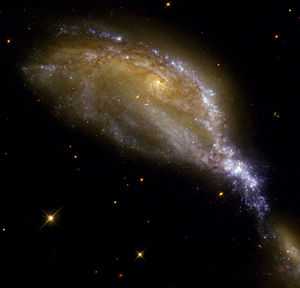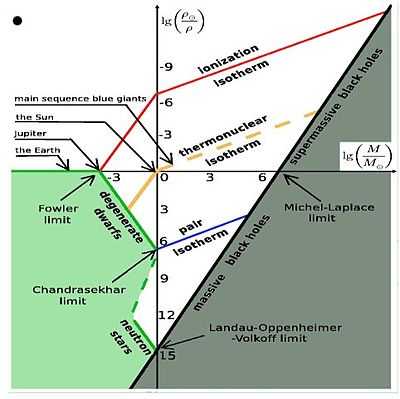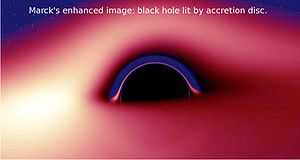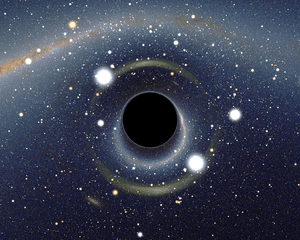Gravitational collapse


Gravitational collapse is the inward fall of an astronomical object due to the influence of its own gravity which tends to draw the object toward its center of mass. In any stable body, this gravitational force is counterbalanced by the internal pressure of the body acting in the opposite direction. If the gravitational force is stronger than the forces acting outward, the equilibrium becomes unstable and a collapse occurs until the internal pressure increases sufficiently that equilibrium is once again attained (the exception being a black hole).
Because gravity is weak compared to other fundamental forces, gravitational collapse is usually associated with very massive bodies or collections of bodies, such as stars (including collapsed stars such as supernovae, neutron stars and black holes) and massive collections of stars such as globular clusters and galaxies.

Gravitational collapse is at the heart of structure formation in the universe. An initial smooth distribution of matter will eventually collapse and cause a hierarchy of structures, such as clusters of galaxies, stellar groups, stars and planets. For example, a star is born through the gradual gravitational collapse of a cloud of interstellar matter. The compression caused by the collapse raises the temperature until nuclear fuel ignites in the center of the star and the collapse comes to a halt. The thermal pressure gradient (acting outward) balances the gravity (acting inward) and the star is in dynamic equilibrium between the two forces.
Stellar remnants
Gravitational collapse of a star occurs at the end of its thermal pressure supported lifetime. At what is called the death of the star, when all stellar energy sources are exhausted, the star will undergo a contraction that can be halted only if it reaches a state in which cold matter pressure provides sufficient support, as in a smaller body such as a planet. In this sense a star is in a "temporary" equilibrium state between a gravitational collapse at stellar birth and a further gravitational collapse at stellar death. The end states are called stellar remnants, which may be a compact star or a black hole.
The types of compact star are:
- White dwarfs, in which gravity is opposed by electron degeneracy pressure;
- Neutron stars, in which gravity is opposed by neutron degeneracy pressure and short-range repulsive neutron–neutron interactions mediated by the strong force;
- The other possibility is that of Black holes, in which the physics at the center is unknown.
The collapse to a white dwarf takes place over tens of thousands of years, while the star blows off its outer envelope to form a planetary nebula. If it has a companion star, a white dwarf-sized object can accrete matter from the companion star until it reaches the Chandrasekhar limit (about one and a half times the mass of our Sun) at which point gravitational collapse takes over again. While it might seem that the white dwarf might collapse to the next stage (neutron star), they instead undergo runaway carbon fusion, blowing completely apart in a Type Ia supernova.
Neutron stars are formed by gravitational collapse of larger stars, the remnant of other types of supernova. They are so compact that a Newtonian description is inadequate for an accurate treatment, which requires the use of Einstein's general relativity.
According to Einstein's theory, for even larger stars, above the Landau-Oppenheimer-Volkoff limit, also known as the Tolman–Oppenheimer–Volkoff limit (roughly double the mass of our Sun) no known form of cold matter can provide the force needed to oppose gravity in a new dynamical equilibrium. Hence, the collapse continues with nothing to stop it.

Once a body collapses to within its Schwarzschild radius it forms what is called a black hole, meaning a space-time region from which not even light can escape. It follows from a theorem of Roger Penrose[2] that the subsequent formation of some kind of singularity is inevitable. Nevertheless, according to Penrose's cosmic censorship hypothesis, the singularity will be confined within the event horizon bounding the black hole, so the space-time region outside will still have a well behaved geometry, with strong but finite curvature, that is expected[3] to evolve towards a rather simple form describable by the historic Schwarzschild metric in the spherical limit and by the more recently discovered Kerr metric if angular momentum is present.
On the other hand, the nature of the kind of singularity to be expected inside a black hole remains rather controversial. According to some theories, at a later stage, the collapsing object will reach the maximum possible energy density for a certain volume of space or the Planck density (as there is nothing that can stop it). This is when the known laws of gravity cease to be valid.[4]There are competing theories as to what occurs at this point, but it can no longer really be considered gravitational collapse at that stage.[5]
It might be thought that a sufficiently large neutron star could exist inside its Schwarzschild radius and appear like a black hole without having all the mass compressed to a singularity at the center; however, this is a misconception. Within the event horizon, matter would have to move outward faster than the speed of light in order to remain stable and avoid collapsing to the center. No physical force therefore can prevent the star from collapsing to a singularity (at least within the currently accepted framework of general relativity; this doesn’t hold for the Einstein–Yang–Mills–Dirac system). A model for nonspherical collapse in general relativity with emission of matter and gravitational waves has been presented.[6]
See also
References
- ↑ Class. Quantum Grav. 13 (1996)p393
- ↑ "Gravitational collapse and space-time singularities", R. Penrose, Phys. Rev. Let. 14 (1965) p 57
- ↑ B. Carter, "Axisymmetric black hole has only two degrees of freedom", Phys. Rev. Let. 26 (1971) p331
- ↑ "Black Holes - Planck Unit? WIP". Physics Forums. Archived from the original on 2008-08-02.
- ↑ Brill, Dieter (19 January 2012). "Black Hole Horizons and How They Begin". Astronomical Review.
- ↑ Bedran, ML et al.(1996)."Model for nonspherical collapse and formation of black holes by emission of neutrinos, strings and gravitational waves", Phys. Rev. D 54(6),3826.
External links
| ||||||||||||||||||||||||||||||||||||||||
